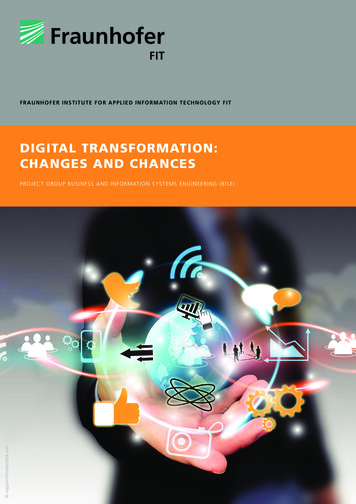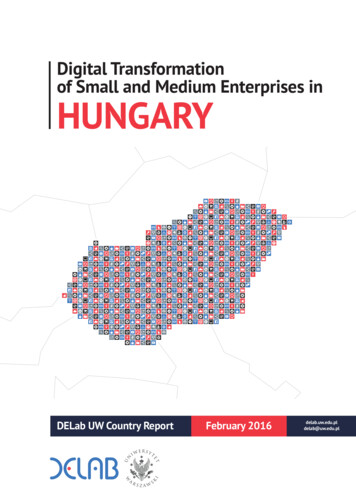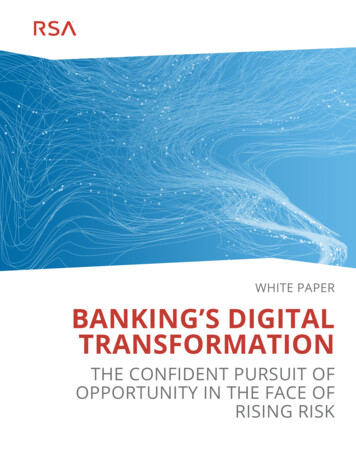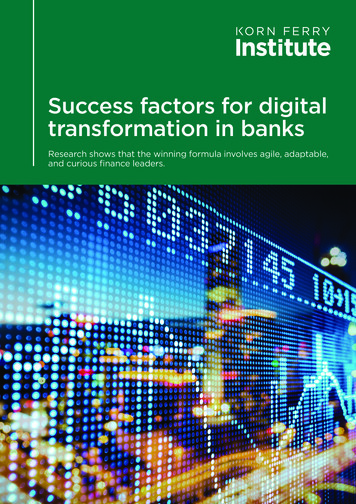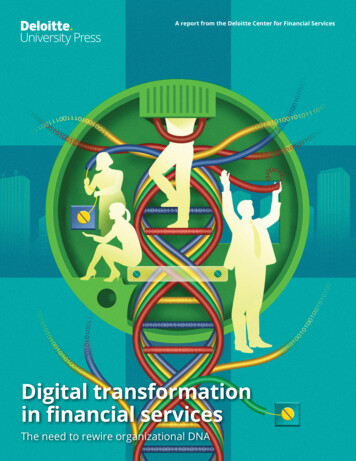
Transcription
Digitaltransformation for2020 and beyondA global telecommunicationsstudyA global telecommunications study1
About this reportThe 2017 global telecommunications study has been conducted by EY to monitor andevaluate the evolving views of leaders across the global telecommunications industry.This latest survey forms part of EY’s ongoing series of global telecommunications studies.Based on in-depth conversations with industry leaders worldwide, the resulting insightshelp us to assess the current state and future state of this rapidly changing sector.Our 2017 survey drills down into perspectives from the industry’s CIO and CTOcommunity in order to explore the role of IT and networks and to examine how this issupporting long-term digital transformation.We conducted 39 in-depth interviews with participants from 36 organizations, supportedby insights and analysis from EY’s sector professionals and secondary research sources.The 36 organizations taking part this year account for annual revenue of US 421 billionand an aggregate market capitalization of US 603 billion.Figure 1: Participating companies in 2017 — annual revenuesNumber of participating companiesGreater than US 25b4US 10b–US 25bUS 5b–US 9.9b73US 1b–US 4.9bLess than US 500m1460 2 4 6 8 10 12 14 16 182Digital transformation for 2020 and beyond
2017 global telecommunications study:highlights39 interviews with 36 organizationsParticipantorganizations’annual revenue:Participant organizations’aggregate marketcapitalization:US 421billionUS 603billionTaken together, our 2015 and 2017 surveys have involved a total of 83 interviews with76 organizations, with the aggregate annual revenues of the participating companiesstanding at over US 1 trillion. These interviews have covered 44% of the top 50 globalcarriers by revenue.Figure 2: : Geographic locations of participating companies, 2015 and 2017Headquarters locations of participating entities in 2015 and 2017A global telecommunications study3
Participating industry executives*Cosmas AdamChief Technology and Information OfficerMTN CyprusDaniel Mizrachi BelisarioChief Technology OfficerMillicom International Cellular Costa RicaEnrique BlancoChief Technology OfficerTelefonica GroupAxel ClaubergVice President, Aggregation, Transport, IP(CTO-ATI)Deutsche TelekomJay FerroExecutive Vice President, Chief InformationOfficer, Chief Product OfficerEarthLinkVikas GroverChief Information OfficerVodafone IndiaDavid HavercroftChief Operating OfficerSpark New ZealandKashif Syed HaqChief Technology OfficerAxiata DigitalMike ColeChief Information OfficerBell CanadaHisham Fathy HassanDirector, Technology Strategy & ControlViva BahrainNicolas CostarasChief Information OfficerWind HellasLuis Martin HernandezChief Information OfficerAmerica Movil — Telcel (Mexico)Claudio FarinaHead Financial Planning & AnalysisVodafone ItaliaBouke HovingExecutive Vice President Simplification &Innovation and CIOKPN4Digital transformation for 2020 and beyondPhil JordanChief Information OfficerTelefonica GroupPanicos KallenosChief Technology and Information OfficerCYTAVeenod KurupGroup Chief Information OfficerLiberty GlobalFrancois MaireyChief Technology and Information OfficerTele2 GroupAmit MarwahHead of Sales, End to End SolutionsNokia Solutions and Networks IndiaGary McLarenChief Technology OfficerHKBNShin MurakamiCorporate Officer, ExecutiveVice President, Chief Mobile OfficerYahoo Japan
Ali ObtelChief Technology OfficerViva KuwaitDaniele SchneebergHead of TransformationVodafone ItaliaTommy OleniusChief Technology OfficerDNA OyjKen SmithardVice President, PerformanceOrganizational Efficiency & ITCogeco ConnexionPeter JantosovicDirector Technology Transformation &OptimizationSlovak TelekomGunar PostHead of IT StrategyDeutsche TelekomScott RiceChief Information OfficerSprint CorporationJohn RomanoActing Chief Information OfficerTelstraRuza SabanovicChief Technology and Information OfficerTelenor GroupPeter TaylorVice President, TechnologyOperations and SupportShaw Communications IncHugo Van ZylChief Technology and Information OfficerOpenServe Pty Ltd (Telkom Group)Saad Muzaffar WaraichChief Technology and Information OfficerPTCL PakistanMarlon Yu-ShanChief Information Officer, MillicomInternational Cellular Honduras*Five participants requested to remain anonymous.*Three participants asked to remain anonymous.A global telecommunications study5
The methodologyWe met with each of the seniorindustry executives who participatedin the study, asking them 15 questionsthat focused on the industry as awhole, as well as on specific areasand issues within their organizations.We asked participants to providetheir top three answers to providefull insight into the opportunities andchallenges confronting them nowand in the future. We also capturedkey comments from the dialoguegenerated by the interviews, ananonymized selection of whichappears in this report.If you would like to the see thecomplete results of the study, pleasecontact your local EY representative.6Digital transformation for 2020 and beyond
Sector snapshot: the paradigmshift to digital is well underwayThe global telecoms industry landscape is changing faster thanever. Erosion of legacy revenue streams driven by over-the-top(OTT) competitors continues, forcing operators to consider newways of remaining relevant to consumer and enterprise customers.While many have embarked on journeys to become digitalservice providers, the sector remains vulnerable to quickeningshifts in terms of technology cycles, competitor actions andcustomer needs.A decade of disruptive dynamicsTelecommunications companies have endured a challengingdecade, with the industry subjected to a number of disruptions inrecent years. The smartphone revolution has led to an explosionin data demand, while the accompanying growth of mobileapplications has seen a range of disruptive players monetize newcustomer behaviors.While this has resulted in a range of interconnected phenomena,from the sharing economy to frictionless marketplaces, operators’revenue streams remain under pressure. The rise of OTT playershas been accompanied by macroeconomic pressure and mandatedprice reductions to mobile termination and roaming rates thathave further weakened the sector’s growth profile. During theperiod 2008 to 2016, global fixed and mobile revenues increasedat a compound annual growth rate of 0.4%.At the same time, network investments remain burdensome asoperators upgrade their infrastructure to sustain an exponentialrise in data demand. Large-scale 4G rollout continues, supportedby the acquisition of new spectrum frequencies, while lastmile connections to the home are also the scene of continuedinvestment.Figure 3: Global telecoms revenue development 2008-16 (US 3201420152016FixedSource: Ovum“ Consumer interaction with devices creates instant needs. The challengefor us is to keep up with customer demands given our legacy networkelements and investments.”A global telecommunications study7
Regional landscapes vary in telecommunicationsFrom a geographical perspective, North American and Asia-Pacifictelcos have performed best in terms of share prices in the pastfive years. This outperformance has been helped by consolidatedmarket structures and early access to new spectrum in NorthAmerica and by strong smartphone penetration growth anddemand for mobile data services in Asia-Pacific.remain difficult to predict. External factors are weighing downtelco share performance in emerging regions, whether in theform of recession in Latin America or falling commodity prices inAfrica. And while telcos across regions remain well-positioned asdefensive stocks, dividend yields remain under pressure, havingtrended slightly down in recent years.Meanwhile, European telco stocks have recovered since 2013due to the anticipation of large-scale M&A — yet although therevenue growth outlook is improving, regulatory attitudesFigure 4: Operator share performance160%140%120%100%80%60%MSCI AC Asia Telecoms IndexDJ Euro Stoxx Telecoms IndexDow Jones U.S. Telecoms IndexSource: Capital IQDigital transformation for 2020 and y-15Feb-15Nov-14MSCI EM Latin America Telecoms IndexDow Jones Middle East & Africa Telecoms v-12Aug-12May-1240%
Telcos are diversifying their revenue streams but marginmanagement remains challengingTelcos in all regions have expanded their service portfolios inrecent years to include a widening array of offerings, as they lookto capitalize on growth opportunities across technology, mediaand telecommunications (TMT) in areas like enterprise cloud, TVand the Internet of Things (IoT). Meanwhile rapid smartphoneadoption is driving growth in areas such as mobile advertising,and bundles with new combinations of fixed, mobile and TVservices are gaining ground.Figure 5: Digital TMT ecosystem value forecastUS 2.36 trillion24%US 1.67 , a key challenge for telcos as they expand their serviceportfolios is that adjacent market segments tend to offer lowermargins, and disruptive competitors are already well-positionedin key segments such as cloud and advertising.Partly as a result, profitability is under pressure, with operators’return on invested capital (ROIC) trending downward. Incombination with the lower margins available from adjacentservices, this squeeze on profitability reflects other factors,including regulatory price reductions and the high capitalintensity required to service the surging demand for mobile data.23%Voice/SMSDataContent and videoloT and M2MAdvertisingEnterprise and cloudSource: Informa, Ovum, GSMA, EY“ The future for telcos is uncertain. Players are taking virtual positions inthe market, but it is doubtful whether they are substantially differentfrom each other.”A global telecommunications study9
Competitive intensity is higher than everOTT players such as WhatsApp, Facebook and WeChat haveredefined the customer experience in messaging and videoservices, luring traffic away from telco offerings such as SMS.These trends are playing out against a market background inwhich consumers and enterprises increasingly see value in multiservice packages, with quad-play and cloud packages driving newopportunities in each segment respectively.Figure 6: Active user base of major instant messagingplatforms (billions)However, many consumers are looking to customize their ownbundle combinations, with OTT video playing an increasinglyimportant role — in turn driving further M&A and partnerships.Meanwhile, on the enterprise side, telcos are seeking growth byoffering more advanced services to multinational customers. Thisshift is fostering a growing focus on strategic services based onIP, Ethernet, VPN and managed services capabilities. In focusingon network-adjacent services, telcos’ aim is to “protect the core”while also avoiding head-on competition with IT outsourcers andtechnology specialists.3.62.81.91.12013201420152016Source: GSMAOverhaul of systems and processes is fueling telcos’ digitaltransformationIT spending by telcos is set to keep rising through the period from2015 to 2020, as operators leverage new hardware and softwarein search of long-term efficiency gains and greater agility andflexibility. However — as Figure 7 shows — spending profiles asa proportion of revenues vary between regions, with Americasoperators demonstrating higher relative spending propensity.The rising global trend in IT spend reflects the fact that suchinvestment remains critical to supporting digital growth, withquality of experience and reduced costs at the heart of operators’strategic agenda. While budget constraints in developed marketsare dis-incentivizing large-scale transformation programs,emerging markets will continue to drive IT spending growththrough 2020. In combination, these factors are projected to seeglobal telco IT investment reach US 85b in 2020, with 74% of thistotal being spent with external providers rather than internally.1Growth in spending on systems hardware and packaged softwarewill be particularly strong, reflecting the move to more flexiblevirtualization technologies. In contrast, internal IT spendingon areas like IT desktop capabilities and IT departments willsee relatively slow growth between 2015 and 2020, at aCAGR of just 1%.Figure 7: Global telco IT spending forecast by region54.543.520142015North AmericaSource: Ovum1Ovum.10Digital transformation for 2020 and ��c
Capital intensity is set to rise toward the end of the decadeCarriers’ capital expenditure has been falling following theirlarge-scale 4G and fiber rollouts. However, as Figure 8 illustrates,an acceleration of “pure fiber” rollouts and the advent of 5G willlead to sharp rises in capex in 2020–21, both in fixed and mobilesegments. Operators will need to consider new ways of generatingcapex efficiency as they strive to meet growing demand forhigh-speed and low-latency data services.Figure 8: Global telecoms capex development (US b) 350 300 250 200 150 100 50 9F2020F2021FSource: OvumA global telecommunications study11
Headline survey findingsLooking across the views of the global telecoms industry leaders elicited in our research, eight key messages emerge strongly.Eight key messages from our research1. Disruptive competition tops the list of industry challenges.2. Digital business models, customer experience and costcontrol lead the 2020 strategic agenda.3. The network dominates the near-term spending agenda,but a range of IT improvements are also being sought.4. Network capex is trending up but IT spending profiles vary.12Digital transformation for 2020 and beyond5. Confidence is rising in the digital services opportunity,yet caveats remain.6. Analytics and virtualization are the top
investment remains critical to supporting digital growth, with quality of experience and reduced costs at the heart of operators’ strategic agenda. While budget constraints in developed markets are dis-incentivizing large-scale transformation programs, emerging markets will continue to drive IT spending growth through 2020. In combination .

